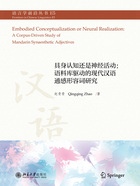
1.1.2 Underlying mechanisms
There is a debate on the mechanisms underlying linguistic synaesthesia. One theoretical model was proposed in the framework of Cognitive Linguistics, which generally treats linguistic synaesthesia as a specific type of metaphor (Geeraerts 2010). This explanatory model claims that linguistic synaesthesia, similar to other types of metaphor, is also grounded in how our bodies experience the world, i.e., the perceived similarity of intensity and subjective evaluation (Shen 1997; Yu 2003; Popova 2005; among others). In this model, linguistic synaesthesia would follow the tendency of mapping from more embodied domains to less embodied ones, like other types of metaphor (see Lakoff and Johnson 1980; Johnson 1987).
In addition, as the source domain and the target domain of linguistic synaesthesia are both bodily and concrete sensory modalities, Shen (1997)argued that additional features should be introduced to differentiate the degrees of embodiment of different sensory modalities. The study has pointed out that touch and taste necessarily involve physical contact between sensory organs and perceived objects, while the other three modalities (i.e., vision, hearing, and smell)do not require such physical contact. Therefore, touch and taste are claimed to be more embodied than vision, hearing, and smell in Shen’s work.
Shen (1997)has also suggested that tactile perceptions, unlike other senses, do not require a specialized sensory organ, but instead have receptors all over the body. Hence, he proposed a rank of embodiment for five sensory modalities: touch is the most embodied sense, and taste follows, while vision, hearing, and smell are less embodied. Based on the ranking of the embodiment of five senses, Shen has contended that the directions of linguistic synaesthesia described in Figure 1 (cf.p.3)are constrained by the embodiment mechanisms, i.e., mapping from the more embodied to the less embodied.
Similarly, Popova (2005:416)suggested that embodiment is realized “at its strongest in touch”, since scalarity and subjective evaluation of sensory stimuli dominate the perceptual experiences of touch (including taste), but not those of vision and hearing. Therefore, she assumed that the conceptualization of perceptual properties in vision and hearing in terms of concepts from touch and taste, illustrated the move from the more embodied to the less embodied.
The embodiment account for linguistic synaesthesia, however, has been criticized for its disregard of neural associations in the brain and of earlier occurrences of linguistic synaesthesia in the speech of young children compared to other kinds of metaphor. On the contrary, when we take the neural associations and the earlier occurrences of linguistic synaesthetic expressions into consideration, they might indicate that biological factors are at work (see Gardner 1974; Keil 1986; Marks et al.1987; Seitz 1997; Seitz 2005). For instance, Ramachandran and Hubbard (2001:18)have proposed that linguistic synaesthesia is the same as neurological synaesthesia, as both are shaped by “anatomical constraints” that permit “certain types of cross-activation, but not others”. Seitz (2005:90)has pointed out that linguistic synaesthesia is an “inborn metaphorical association” that is “pre-wired” in brains.
Linguistic studies, such as Williams (1976)and Rakova (2003), also followed the biological association account for linguistic synaesthesia. For example, Rakova (2003)has suggested that the tactile meaning and the gustatory meaning of the English adjective hot are associated because of the same neural pain-detecting mechanism (i.e., VR1, Caterina et al.1997), rather than through metaphorical mappings. In addition, Rakova (2003:64)has assumed that neurological synaesthesia is a “strong synaesthesia” and linguistic synaesthesia is a “weak synaesthesia”, both of which are analogous with respect to the innate neural associations between senses.
The biological association account of linguistic synaesthesia has also been challenged. For instance, Day (1996)compared types of neurological synaesthesia documented in Cytowic (2002 [1989])with linguistic synaesthesia collected from English and German novels. The research found that the two kinds of synaesthetic phenomena did not share the same patterns. For instance, colored sounds (i.e., the association between vision and hearing)were found to be the most common for neurological synaesthesia, while tactile sounds (i.e., the association between touch and hearing)were the most frequent for linguistic synaesthesia (Day 1996). Another criticism to the biological association account for linguistic synaesthesia is that the theory does not provide any explicit explanation for the directional tendency of linguistic synaesthesia (Popova 2005).
Zhao et al.(2018b)tested the two rival theoretical models of mechanisms underlying linguistic synaesthesia, based on their different predictions of synaesthetic tendencies in languages. The study attempted to determine whether the directionality of mappings from the more embodied to the less embodied for linguistic synaesthesia predicted by the embodiment account, or the cross-linguistic universality of transfer patterns suggested by the biological association account, can be supported by real linguistic data. Based on plentiful data from the Sinica corpus (Chen et al.1996), the study found that distributions and tendencies of synaesthetic uses of gustatory adjectives in both Mandarin and English could not be explained or predicted by either single theory. Rather, linguistic synaesthesia can be accounted for by the combination of the two theories (Zhao et al.2018b).